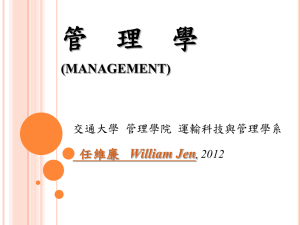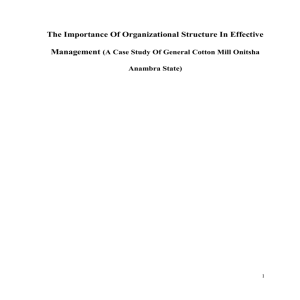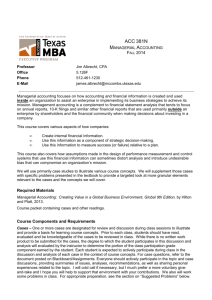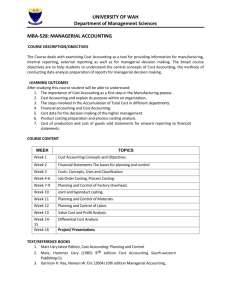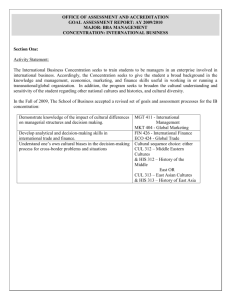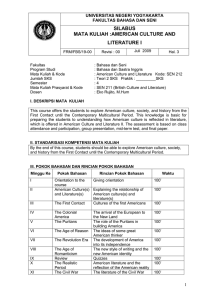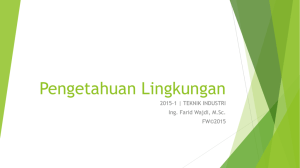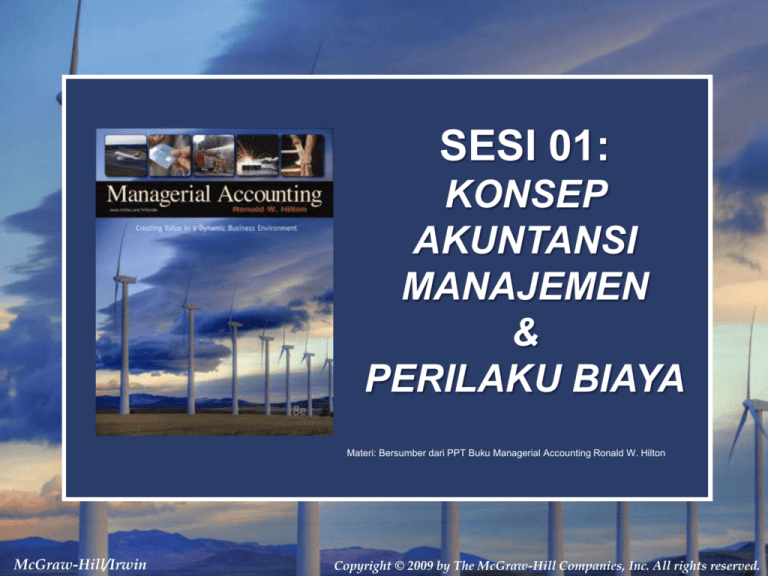
SESI 01:
KONSEP
AKUNTANSI
MANAJEMEN
&
PERILAKU BIAYA
Materi: Bersumber dari PPT Buku Managerial Accounting Ronald W. Hilton
McGraw-Hill/Irwin
Copyright © 2009 by The McGraw-Hill Companies, Inc. All rights reserved.
Tak Kenal Maka TaK SaYang..
TAK KENAL MAKA TAK SAYANG...
NAMA
: ACHMAD ZAKY,SE.,MSA.,Ak.,SAS.,CMA.,CA
NICK NAME : BANG JACK / ABU DZAKY
TTL
: MALANG,24 OKTOBER 1984
BLOG
: keuangansyariah.lecture.ub.ac.id
PENGALAMAN:
• STAFF AKADEMIK JAFEB UB
• KETUA & TRAINER TETAP IFAS
• KABID PENGAWASAN KEUANGAN - SPI UB
• AUDITOR – KAP KBAA
• TRAINER TETAP CAAT FORUM
• SEKRETARIS PROGRAM PPAk JAFEB UB (s/d 2014)
• STAF KEUANGAN PPAk JAFEB UB (s/d 2010)
Deskripsi Matakuliah
Matakuliah ini merupakan kelanjutan dari mata kuliah
yang sama pada program S1, dimana penekanan
pada kuliah ini adalah mengenai penerapan konsepkonsep tersebut dalam dunia praktek. Selain itu, juga
akan dibahas perkembangan muthakhir dalam bidang
akuntansi manajemen, seperti:
• activity-based costing, dan
• quality costing, target costing.
Mata kuliah ini merupakan mata kuliah tingkat lanjutan.
Pemahanan mengenai basic management accounting
harus sudah dimiliki oleh mahasiswa untuk bisa
mengikuti mata kuliah ini dengan baik.
1-4
Metode Pengajaran
Kuliah akan diselenggarakan dengan model
diskusi dengan mempergunakan kasuskasus yang diberikan.
Peserta pendidikan profesi diwajibkan
untuk membaca materi yang ada dan
membahas kasus-kasus yang diberikan.
Partisipasi aktif peserta pendidikan
profesi dalam diskusi sangat dibutuhkan, dan
akan menentukan nilai akhir.
1-5
Define Managerial Accounting
Managerial accounting is the process of
Identifying
Measuring
Analyzing
Interpreting
Communicating information
1-6
Managing Resources, Activities,
and People
An organization . . .
Directing
Acquires Resources
Decision
Making
Organized set
of activities
Controlling
Planning
Hires People
1-7
How Managerial Accounting Adds
Value to the Organization
• Providing information for decision making and
planning.
• Assisting managers in directing and controlling
activities.
• Motivating managers and other employees
towards organization’s goals.
• Measuring performance of activities, managers,
and other employees.
• Assessing the organization’s competitive position.
1-8
Managerial versus Financial
Accounting
Managerial Accounting
Users of Information Managers, within the organization.
Regulation Not required and unregulated, since it is intended
only for management.
Financial Accounting
Interested parties, outside the organization.
Required and must conform to generally accepted
accounting principles. Regulated by the Financial
Accounting Standards Board, and, to a lesser
degree, the Securities and Exchange
Commission.
Source of Data The organization's basic accounting system, plus Almost exclusively drawn from the organization's
various other sources, such as rates of effective basic accounting system, which accumulates
products manufactured, physical quantities of
financial information.
material and labor used in production, occupancy
rates in hotels and hospitals, and average take-off
delays in airlines.
Nature of Reports and Reports often focus on subunits within the
Reports focus on the enterprise in its entirety.
Procedures organization, such as departments, divisions,
Based almost exclusively on historical transaction
geographical regions, or product lines. Based on a data.
combination of historical data, estimates, and
projections of future events.
1-9
Major Themes in Managerial
Accounting
Behavioral
Issues
Costs and
Benefits
Information
and Incentives
Evolution and
Adaptation
Managerial
Accounting
1-10
Evolution and Adaptation in
Managerial Accounting
E-Business
Product Life Cycles
Time-Based
Competition
Service vs.
Manufacturing Firms
Emergence of New
Industries
Global Competition
Focus on the Customer
Cross-Functional Teams
Change
Information and
Communication
Technology
Just-in-Time Inventory
Total Quality Management
Continuous Improvement
1-11
Cost Management Systems
Objectives
Measure the cost of resources
consumed.
Identify and eliminate nonvalue-added costs.
Determine efficiency and
effectiveness of major
activities.
Identify and evaluate new
activities that can improve
performance.
Cost
Management
System
1-12
Strategic Cost Management and
the Value Chain
Product
Design
Production
Research
and
Development
Securing raw
materials and
other resources
Start
Marketing
Distribution
Customer
Service
1-13
Managerial Accounting as a Career
Professional Organizations
Institute of Management Accountants (IMA) – USA
Institut Akuntan Manajemen Indonesia (IAMI) - Indonesia
Publishes
Management
Accounting
and research
studies.
Administers
Certified
Management
Accountant
program
Develops
Standards of
Ethical
Conduct for
Management
Accountants
1-14
KONSEP
BIAYA
McGraw-Hill/Irwin
Copyright © 2009 by The McGraw-Hill Companies, Inc. All rights reserved.
Types of Production Processes
Type of Production
Description of
Example of
Process
Process
Manufacturer
Job Shop
Low volume
Disney
Little standardization
Unique products
Batch
Multiple products
Caterpillar
Low volume
Assembly Line
A few major products
Ford
Higher volume
Mass Customization
High volume
Dell
Many standardized components
Customized combination of components
Continuous Flow
High volume
Highly standardized commodity products
Exxon
1-16
Manufacturing Costs
Direct
Material
Direct
Labor
Manufacturing
Overhead
The
Product
1-17
Classifications of Costs in
Manufacturing Companies
Manufacturing costs are often
combined as follows:
Direct
Material
Direct
Labor
Prime
Cost
Manufacturing
Overhead
Conversion
Cost
1-18
Manufacturing Cost Flows
Direct Material
Direct Labor
Work in
Process
Inventory
Manufacturing
Overhead
Finished
Goods
Inventory
Cost of
Goods
Sold
1-19
Activities that cause costs to be
incurred are called COST DRIVERS
Cost Driver Examples
Activity
Cost Driver
Machining operations
Machine hours
Setup
Setup hours
Production scheduling
Manufacturing orders
Inspection
Pieces inspected
Purchasing
Purchase orders
Shop order handling
Shop orders
Valve assembly support Customer
Requisitions
1-20
Cost Classifications
Summary of Variable and Fixed Cost Behavior
Cost
In Total
Per Unit
Variable
Total variable cost changes
as activity level changes.
Variable cost per unit
remains the same over
wide ranges of activity.
Total fixed cost remains
the same even when the
activity level changes.
Fixed cost per unit
goes down as activity
level goes up.
Fixed
1-21
Various Costs
Direct costs: Costs that can be easily and conveniently traced to a
product or department.
Indirect costs: Costs that must be allocated in order to be assigned to a
product or department.
Controllable and Uncontrollable Costs: A cost that can be significantly
influenced by a manager is a controllable cost.
Opportunity Costs: The potential benefit that is given up when one
alternative is selected over another.
Sunk Costs: All costs incurred in the past that cannot be changed by any
decision made now or in the future are sunk costs. Sunk costs should
not be considered in decisions.
Differential Costs: Costs that differ between alternatives.
Marginal Cost: The extra cost incurred to produce one additional unit.
Average Cost: The total cost to produce a quantity divided by the
quantity produced.
1-22
PERILAKU
BIAYA
McGraw-Hill/Irwin
Copyright © 2009 by The McGraw-Hill Companies, Inc. All rights reserved.
Introduction
Cost
estimation
Cost
behavior
Cost
prediction
Process of
determining
cost behavior,
often focusing
on historical
data.
Relationship
between
cost and
activity.
Using knowledge
of cost behavior
to forecast
level of cost at
a particular
activity. Focus
is on the future.
6-24
Total Variable Cost Example
Total Pay Per View Bill
Your total Pay Per View bill is based on how many
Pay Per View shows that you watch.
Number of Pay Per
View shows watched
6-25
Variable Cost Per Unit Example
Cost per Pay Per View
show
The cost per Pay Per View show is constant. For
example, $4.95 per show.
Number of Pay Per
View shows watched
6-26
Step-Variable Costs
Cost
Total cost remains
constant within a
narrow range of
activity.
Activity
6-27
Total Fixed Cost Example
Monthly Basic
Cable Bill
Your monthly basic cable TV bill probably does not
change no matter how many hours you watch.
Number of hours watched
6-28
Step-Fixed Costs
Total cost doesn’t change for a wide range of activity,
and then jumps to a new higher cost for the next
higher range of activity.
Rent Cost in
Thousands of Dollars
90
60
30
0
1,000
2,000
3,000
Rented Area (Square Feet)
6-29
Semivariable Cost
Total Utility Cost
Slope is
variable cost
per unit
of activity.
Variable
Utility Charge
Fixed Monthly
Utility Charge
Activity (Kilowatt Hours)
6-30
Engineered, Committed and
Discretionary Costs
Committed
Discretionary
Long-term, cannot be
reduced in the short
term.
May be altered in the
short term by current
managerial decisions.
Engineered
Physical relationship
with activity measure.
Depreciation on
Buildings and
equipment
Direct
Materials
Advertising and
Research and
Development
6-31
Account Classification Method
Cost estimates are based on a
review of each account making up
the total cost being analyzed.
6-32
Visual-Fit Method
A scatter diagram of past cost behavior
may be helpful in analyzing mixed costs.
Total Cost in
1,000’s of Dollars
Estimated fixed cost = $10,000
20
10
* *
* *
* ** *
Vertical distance
**
is total cost,
approximately
$16,000.
0
0
1
2
3
4
Activity, 1,000’s of Units Produced
6-33
The High-Low Method
OwlCo recorded the following production activity
and maintenance costs for two months:
High activity level
Low activity level
Units
9,000
5,000
Cost
$ 9,700
6,100
Using these two levels of activity, compute:
the variable cost per unit.
the total fixed cost.
6-34
The High-Low Method
High activity level
Low activity level
Change
Units
9,000
5,000
4,000
Cost
$ 9,700
6,100
$ 3,600
Unit variable cost = $3,600 ÷ 4,000 units = $.90 per unit
Fixed cost = Total cost – Total variable cost
Fixed cost = $9,700 – ($.90 per unit × 9,000 units)
Fixed cost = $9,700 – $8,100 = $1,600
6-35
REFERENSI : WAJIB
Ronald Hilton,
Managerial
Accounting:
Creating Value in
a Dynamic
Business
Environment, 7th
Edition: McGrawHill (2008) (RH).
1-36
REFERENSI : PENDUKUNG
Don Hansen and
Maryanne
Mowen, Cost
Management;
Accounting and
Control, 5th ed,
ThomsonSouthwestern,
2006 atau edisi
terbaru (HM)
1-37
REFERENSI : PENDUKUNG
John K. Shank,
Cases in Cost
Management; A
Strategic
Emphasis, 3rd
edition,
ThompsonSouthwestern,
2006.
1-38
SILABUS PERKULIAHAN
1-39
SILABUS PERKULIAHAN
1-40
SILABUS PERKULIAHAN
1-41
SILABUS PERKULIAHAN
1-42
Penilaian
• Partisipasi/Keaktifan
• Analisis Kasus dan Presentasi
• Penulisan & Penyajian Makalah
• Middle Test
• Final Test
20%
20%
10%
25%
25%
PENUGASAN RUTIN
1-44
End of Sesion 1
1-45



